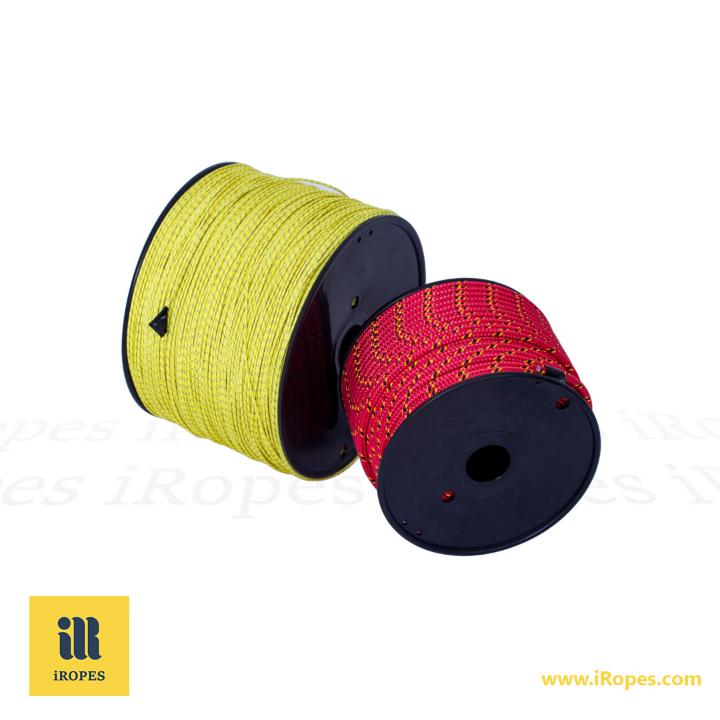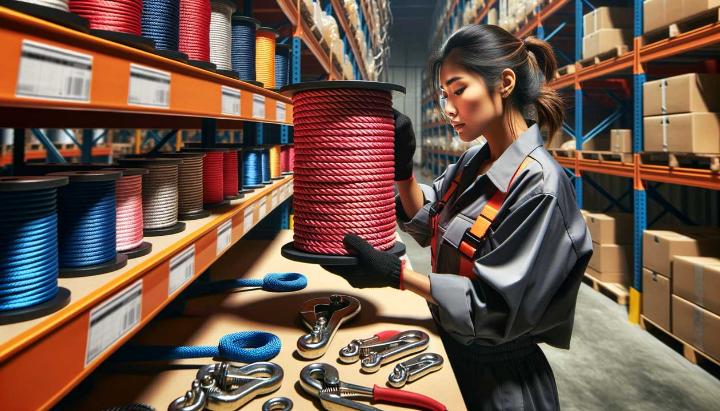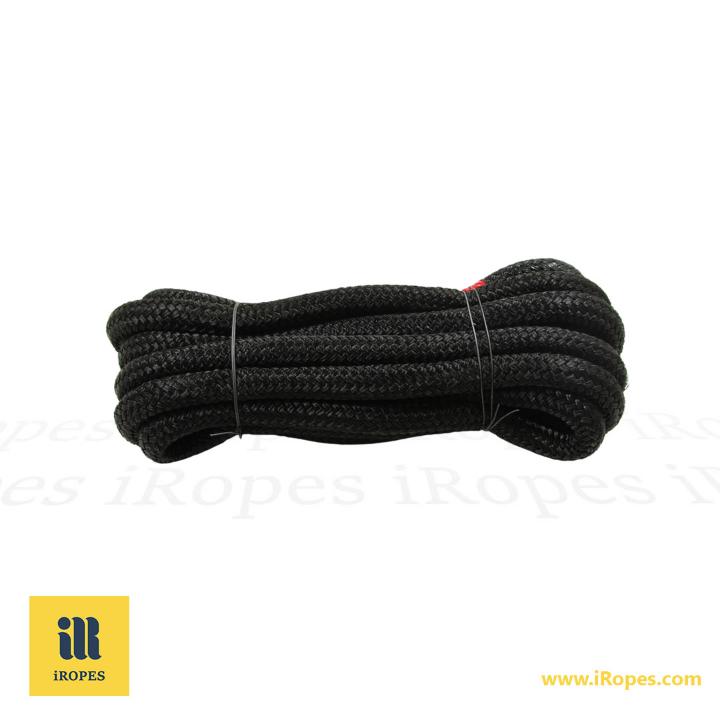Picture this: you're scaling a sheer rock face, your heart pounding with adrenaline as you grip the nylon rope that tethers you to safety. Or perhaps you're a seasoned sailor, relying on sturdy lines to harness the wind and navigate the open seas. In these high-stakes scenarios, the integrity of your ropes – and the clamps that secure them – can mean the difference between success and disaster.
Enter the humble yet mighty nylon rope clamp. These unsung heroes of the rope world are engineered to handle the demands of synthetic materials like nylon , used in everything from winch ropes to climbing gear. With their unique saddle design and durable construction, nylon rope clamps provide a secure grip without damaging the delicate fibers, ensuring your ropes remain intact and reliable no matter the challenge.
In this comprehensive guide, we'll delve into the essential tips for using nylon rope clamps effectively, unlocking the secrets to safe and efficient rigging, anchoring, and securing – whether you're a weekend warrior or a professional in a rope-intensive field. From selecting the right clamp for your needs to mastering proper installation and maintenance, we've got you covered. So brace yourself for a journey into the world of nylon rope clamps, where safety and confidence meet innovation and versatility.
Understanding Rope Clamps: Basics and Applications
Rope clamps are essential hardware used to secure ropes in various applications, from rock climbing and sailing to industrial rigging and construction. Whether you're a weekend adventurer or a professional in a rope-intensive field, understanding the basics of rope clamps is crucial for ensuring safety and efficiency.
What are Rope Clamps?
At their core, rope clamps are simple yet effective devices that grip and secure ropes in place. They typically consist of three main components: a U-bolt, a saddle, and nuts. The U-bolt wraps around the rope, while the saddle sits on top, creating a secure grip when the nuts are tightened. Rope clamps are commonly made from durable materials like steel or aluminum to withstand the rigors of various environments.
Types of Rope Clamps
While they share a basic design, rope clamps come in different types to accommodate various rope materials and applications. Here are some common varieties:
- Wire rope clamps are designed for use with steel cables and are often found in rigging and heavy-duty industrial settings.
- Nylon rope clamps are specifically engineered for synthetic ropes like nylon, making them popular choices for climbing, sailing, and other outdoor activities.
- Specialty clamps are available for unique applications, such as those designed for use with fire hoses or in hazardous environments.
Installing Rope Clamps Correctly
Proper installation is crucial for ensuring the safety and reliability of rope clamps. The process typically involves the following steps:
- Prepare the rope end by creating a loop of the appropriate size.
- Position the U-bolt on the dead end (the stationary part) of the rope.
- Place the saddle on the live end (the moving part) of the rope.
- Tighten the nuts according to the manufacturer's recommended torque specifications, ensuring a snug and secure fit.
Remember, improper installation can lead to slippage, fraying, or even catastrophic failure, so it's essential to follow the manufacturer's instructions carefully. Avoid common mistakes like mixing different types of clamps or using them on incompatible rope materials.
With a solid understanding of the basics, you're well on your way to utilizing rope clamps safely and effectively in your adventures or professional endeavors. Stay tuned for more essential tips on selecting the right clamps, ensuring secure clamping, and maintaining these vital pieces of equipment.
Selecting the Right Rope Clamp for Your Application
When it comes to winch ropes and rigging, selecting the appropriate rope clamp is more than just a matter of convenience – it's a critical safety consideration. Using the wrong clamp can lead to catastrophic failures, putting lives and equipment at risk. That's why it's crucial to take the time to understand the different types of rope clamps and the factors that should guide your selection process.

Understanding Wire Rope Clamp Types
One of the most crucial factors to consider is the type of rope clamp you need. For winch ropes, the two most common options are stainless steel and galvanized wire rope clamps. Stainless steel clamps are highly durable and resistant to corrosion, making them ideal for outdoor applications and marine environments. Galvanized clamps, on the other hand, are more cost-effective but may require additional protection against rust and corrosion.
Another option to consider is nylon rope clamps, which are specifically designed for use with synthetic ropes like nylon . These clamps feature a unique saddle design that grips the rope securely without damaging the fibers, making them a popular choice for sailing, climbing, and other outdoor pursuits.
Factors to Consider When Choosing Wire Rope Clamps
- Rope diameter is a critical consideration when selecting the right clamp size. Using a clamp that's too small or too large can compromise the grip and increase the risk of slippage or damage.
- Load capacity is another essential factor. Make sure to choose a clamp that can handle the expected loads and forces with an appropriate safety margin.
- Environmental conditions should also be taken into account. If you'll be operating in harsh or corrosive environments, opt for clamps made from corrosion-resistant materials like stainless steel.
For complex or high-risk applications, it's always a good idea to consult with experts or refer to industry guidelines to ensure you're selecting the most appropriate rope clamp for your needs. And remember, when it comes to safety equipment, investing in high-quality, durable clamps from reputable manufacturers is always a wise choice.
Choosing the right rope clamp is a crucial step in ensuring the safety and reliability of your winch ropes and rigging systems. By considering factors like rope material, diameter, load capacity, and environmental conditions, you can make an informed decision that will help keep your operations running smoothly and securely.
Proper Installation and Use of Nylon Rope Clamps
Have you ever encountered a situation where you needed to secure a nylon rope but struggled to find the right way to do it? Nylon rope clamps are the perfect solution, providing a quick, efficient, and reliable method to create secure loops and terminations. However, proper installation and usage are crucial to ensure the safety and longevity of your rope setup.
How to Install Nylon Rope Clamps Correctly
Installing nylon rope clamps might seem like a simple task, but it's essential to follow the proper steps to ensure a secure and long-lasting setup. Here's a step-by-step guide to help you get it right:
- Create a loop: Start by forming a loop at the end of your nylon rope, leaving enough length for the clamp to grip securely.
- Position the clamp: Place the rope clamp's saddle over the dead (stationary) end of the rope, with the U-bolt around the live (moving) end.
- Tighten the nuts: Carefully tighten the nuts on the U-bolt according to the manufacturer's recommended torque specifications. This step is crucial to achieve the proper clamping force.
- Check spacing: Ensure that the clamps are spaced correctly, following the manufacturer's guidelines. Proper spacing is essential for even distribution of the load and to prevent damage to the rope.
- Repeat for additional clamps: If your setup requires multiple clamps, repeat the process with the recommended spacing between each clamp.
Remember, always refer to the manufacturer's instructions, as installation methods may vary slightly between different brands or clamp types. Don't hesitate to seek professional guidance if you're unsure or working on a critical application.
For further insights into why synthetic ropes are favored over steel lifting cables, check out this comprehensive guide.
Common Applications and Uses of Nylon Rope Clamps
Nylon rope clamps are versatile tools with a wide range of applications, both in outdoor recreational activities and industrial settings. Here are some common uses:
- Sailing and boating: Secure mooring lines, halyards, and other rigging ropes with nylon clamps for a safe and reliable setup.
- Climbing and mountaineering: Create secure anchors and belay setups by clamping nylon ropes in various configurations.
- Rescue and safety operations: Nylon rope clamps are essential for creating secure lifelines and rigging systems in emergency response situations.
- DIY projects and home improvement: From securing tarps and awnings to creating makeshift pulleys or rigging systems, nylon rope clamps offer a versatile solution for various household tasks.
One of the significant advantages of using nylon rope clamps is their ability to grip synthetic ropes securely without damaging the fibers. This makes them an excellent choice for applications where preserving the rope's integrity is paramount, such as in climbing or rescue operations.
Remember, no matter the application, always follow industry best practices, safety guidelines, and local regulations when working with nylon rope clamps and rigging setups. Safety should be your top priority.
Learn more about the potential of synthetic rope for winch applications in our detailed article here.
Maintenance and Safety Precautions for Rope Clamps
As reliable as rope clamps are, they require regular maintenance and care to ensure optimal performance and longevity. Neglecting these vital pieces of equipment can lead to serious safety hazards, putting your projects, operations, and even lives at risk. That's why it's crucial to understand the importance of proper maintenance and safety precautions when working with rope clamps.
Proper Inspection and Maintenance of Rope Clamps
Like any mechanical device, rope clamps are subject to wear and tear over time. Regular inspections and maintenance are essential to identify potential issues before they escalate and to keep your clamps in top working condition. Here are some key points to keep in mind:
- Visual inspections: Before each use, conduct a thorough visual inspection of your rope clamps. Look for signs of corrosion, cracks, deformities, or excessive wear on the saddle, U-bolt, and nuts. Any visible damage should be a red flag, and the clamp should be removed from service and replaced immediately.
- Cleaning and lubrication: Dirt, grit, and debris can accumulate on rope clamps, causing premature wear and compromising their grip. Regularly clean your clamps with a soft brush or cloth, and apply a thin layer of rust-preventative lubricant to the threaded components. This simple maintenance step can significantly extend the lifespan of your equipment.
- Tightness checks: Over time, the nuts on rope clamps can loosen due to vibrations, temperature fluctuations, or other environmental factors. Periodically check the tightness of the nuts and ensure they meet the manufacturer's recommended torque specifications. A loose nut can lead to slippage and potentially catastrophic failures.
- Storage and handling: When not in use, store your rope clamps in a clean, dry environment, away from moisture, chemicals, and extreme temperatures. Proper storage and handling practices can prevent unnecessary wear and tear, ensuring your clamps are ready for action when you need them.
Remember, regular inspections and maintenance are not just good practices – they're essential for keeping your rope clamps in safe and reliable working condition. By incorporating these simple steps into your routine, you can minimize the risk of accidents and maximize the lifespan of your valuable equipment.
Safety Guidelines for Using Rope Clamps
In addition to maintenance, following proper safety guidelines is crucial when working with rope clamps. These guidelines are designed to protect you, your team, and your equipment from potential hazards and ensure smooth, safe operations.
Always follow the manufacturer's instructions and industry best practices when installing and using rope clamps. Improper use can lead to serious injuries or equipment damage.
Here are some essential safety guidelines to keep in mind:
- Load rating and capacity: Never exceed the maximum load rating of your rope clamps. Overloading can cause the clamps to fail, leading to catastrophic consequences. Always ensure that your clamps are rated for the expected loads and forces, with an appropriate safety margin.
- Proper installation: Incorrectly installed rope clamps are a ticking time bomb. Follow the manufacturer's instructions to the letter, and ensure that the clamps are positioned correctly, with the proper spacing and tightness. Double-check your work before putting the setup under load.
- Environmental considerations: Factors like temperature, moisture, and chemical exposure can affect the performance and integrity of rope clamps. Choose clamps made from materials suitable for your operating environment, and take necessary precautions to protect them from harsh conditions.
- Personal protective equipment (PPE): When working with rope clamps, always wear appropriate PPE, such as gloves, safety glasses, and sturdy footwear. This will protect you from potential hazards like pinch points, falling objects, or accidental rope lashings.
By following these safety guidelines and maintaining a vigilant, safety-conscious mindset, you can significantly reduce the risk of accidents and ensure that your rope clamps provide reliable and secure performance, no matter the application.
Remember, safety should always be your top priority when working with rope clamps and rigging systems. By investing in high-quality equipment, conducting regular maintenance, and adhering to best practices, you can enjoy the peace of mind that comes with knowing your setups are secure and your operations are running smoothly.
Request Your Custom Rope Solutions Today!
For those utilising nylon winch ropes, understanding the effective use of a rope clamp is critical to ensure safety and reliability. This guide walks you through selecting the right winch rope clamp, proper installation, and maintenance practices to optimise performance and prevent accidents. Remember, choosing high-quality nylon rope clamps and regular inspections are key to maintaining their integrity and securing your operations. For more customised solutions, please fill in the inquiry form above, and let us assist you with your unique needs!